Which Organelles Are Unique To Animal Cells Quizlet
What is cell organelle?
A cell organelle is a tiny cellular construction that performs specific functions within a cell. You lot can recall of cell organelles as a cell'southward internal organs. For case, the nucleus is the cell's brain, and the mitochondria are the cell'southward hearts. Cell organelles are frequently enclosed by their own membranes, which split the cell into many minor compartments for unlike biochemical reactions.
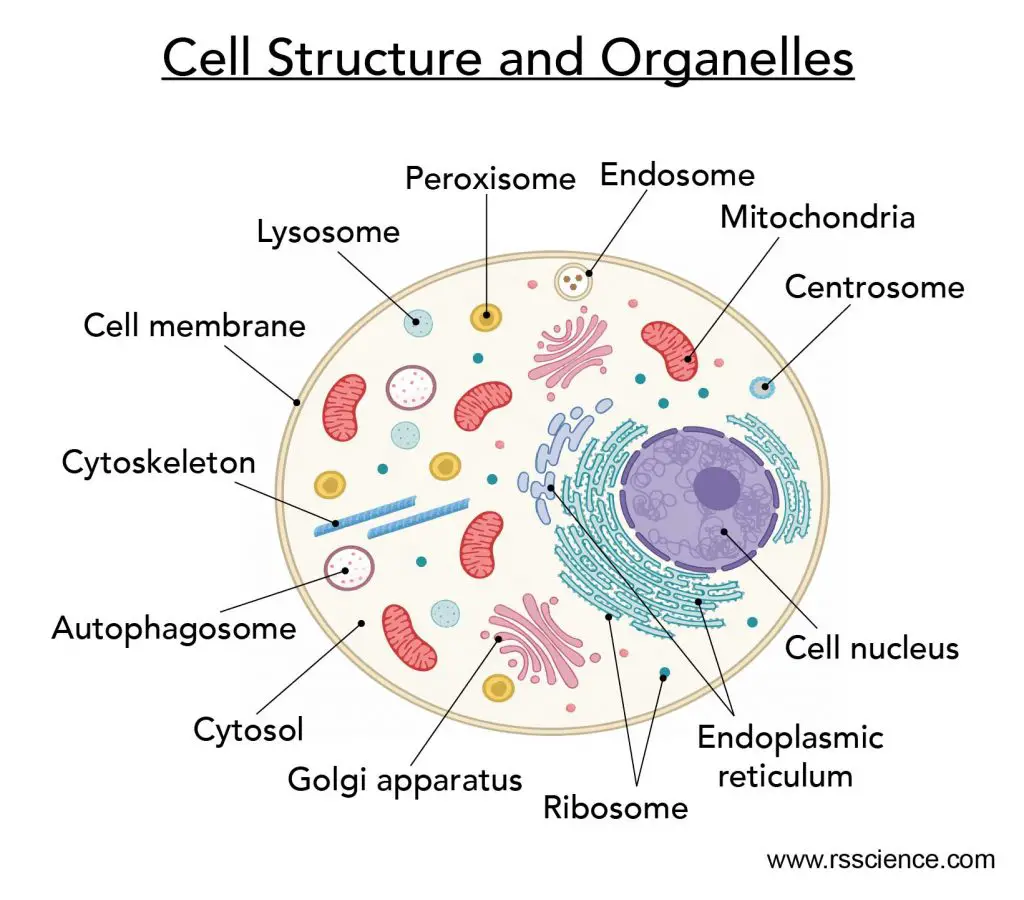
[In this effigy] The anatomy of an animal cell with organelles labeled.
Cell organelles have a broad range of responsibilities, from generating energy for a cell to decision-making its growth and reproduction. From this point of view, you can also think of jail cell organelles as different teams within the factory. Each team carries out its specific task and coordinates to make sure the entire factory works smoothly.
Below is a list of the cell organelles found in animal and found cells, which we'll utilise as our guide for this discussion.
| Cell Organelle | Biological Function | Factory Part |
| Nucleus | DNA Storage | Files and blueprints management |
| Mitochondrion | Free energy production | Powerplant |
| Ribosome | Protein synthesis | Machine to product toys |
| Rough ER | Protein production and modification | Coordination of toy production line and ornament |
| Smooth ER | Lipid product and Detoxification | Accessory product |
| Golgi apparatus | Protein transportation and consign | Packaging and aircraft department |
| Peroxisome | Lipid breakdown; redox reactions | Hazard chemic handling |
| Lysosome | Protein destruction | Recycling |
| Cytoskeleton | Cell movement; intracellular transportation | Conveyor system |
| Cell membrane | Define the inside and outside of a cell | Factory building |
| Prison cell wall | Structural support and protection (constitute cell) | Reinforced factory building |
| Cytosol | Cellular fluid | Internal infinite and floor plan |
| Chloroplast | Photosynthesis (establish cell) | Solar panels |
| Vacuole | Storage and h2o regulation (plant jail cell) | Storage spaces |
Cell organelles can be divided into three types
In this article, we are going to divide these cell organelles/structures into three types:
1. Full general cell organelles: they are present in both animate being and plant cells all the fourth dimension – jail cell membrane, cytosol, cytoplasm, nucleus, mitochondrion, rough and smooth endoplasmic reticulum, Golgi apparatus, peroxisome, lysosome, and the cytoskeleton.
2. Temporal cell organelles: they are only found at specific stages of the cell's life cycle – chromosome, centrosome, autophagosome, and endosome.
3. Cell type specific cell organelles: they simply exist in the institute cells – chloroplast, fundamental vacuole, and cell wall.
Many unique cell organelles/structures only exist in specific cell types. For example, the food vacuoles in amoeba and the trichocysts in paramecia, which cannot be establish in human cells. On the other hand, some human cells likewise have unique organelles that tin't exist found anywhere else, similar the Weibel–Palade bodies in blood vessel cells.
ane. General cell organelles in every cell
Jail cell membrane
- Cell membrane is a biological membrane that separates the interior of the cell from the outside space and protects the cell from its environment.
- Cell membrane is made by two layers of lipid films (oil molecules) with many kinds of membrane proteins.
- Cell membrane controls the motion of molecules such equally water, ions, nutrients, and oxygen in and out of the cell.
- Proteins on the cell membrane also involved in jail cell move and the communication between cells. For case, cells received signals from the exterior earth through different kinds of receptor proteins inserted on the jail cell membrane like tiny antennas.
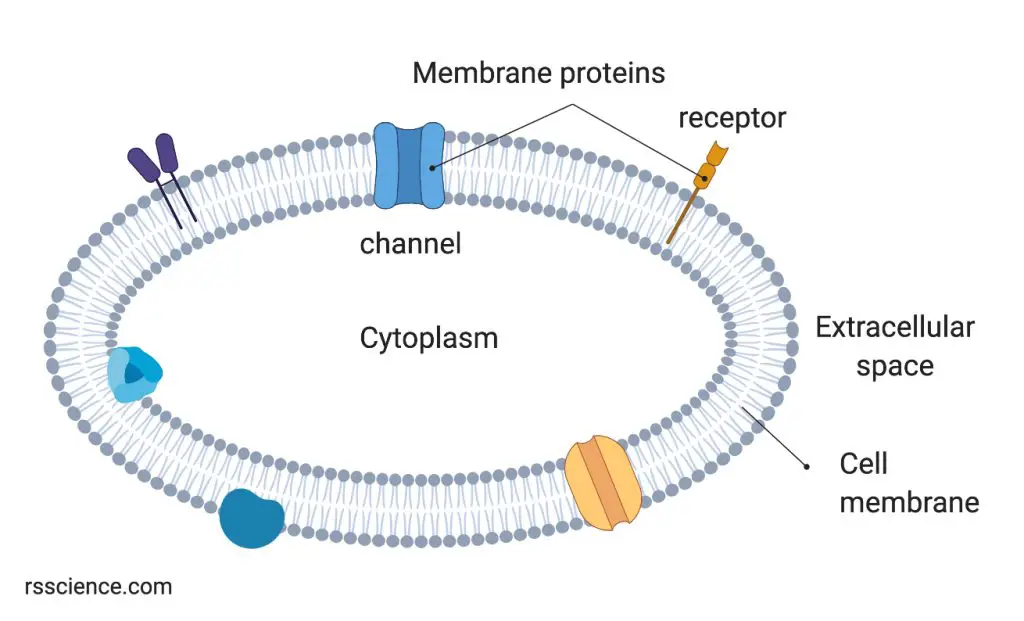
[In this figure] The prison cell membrane defines the inside and outside spaces of a cell. There are many proteins on or inserted in the cell membrane. They function as channels (controlling the in and out of molecules) or receptors (receiving signals from the outside world).
The epitome was created with BioRender.com.
Cytosol
- Cytosol is the cellular fluid inside the cell. It fills up the unabridged intracellular infinite.
- Water is the most arable molecule inside the cells, bookkeeping for lxx% or more than of total cell mass.
- Cytosol is a complex mixture of all kinds of substances dissolved in water, including small molecules similar ions (sodium, potassium, or calcium), amino acids, nucleotides (the bones Deoxyribonucleic acid units), lipids, sugars, and large macromolecules such every bit proteins and RNA.
Cytoplasm
- Cytoplasm refers to all cloth within a cell, enclosed by the cell membrane, except for the prison cell nucleus.
- Cytoplasm includes the cytosol and all the organelles.
Cytoskeleton
- Cytoskeleton is the cells' skeleton organization. Its network reaches every inch within the cells.
- Cytoskeleton is a dynamic network built past interlinking protein filaments. It is composed of iii main components, actin filaments, intermediate filaments, and microtubules.
- Once a portion of the cytoskeleton contracts or extends, it deforms the cells and allows cells to change their shapes and movement.
- Cytoskeleton also serves as a highway system inside the cytosol. Motor proteins can carry cargos while walking forth the cytoskeleton. A variety of intracellular cargoes, including proteins, RNAs, vesicles, and even entire organelles, tin move around inside a prison cell past this intracellular transportation system.
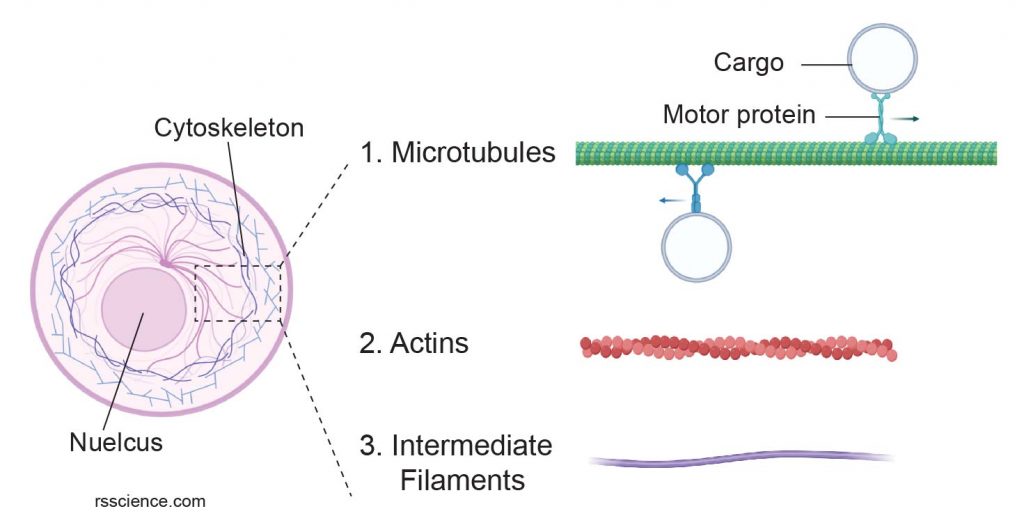
[In this figure] Cytoskeleton consists of three types of filament proteins: microtubules, actins, and intermediate filaments.
The paradigm was created with BioRender.com.

[In this figure] Fluorescent image of vimentin, an intermediate filament protein (dark-green), in human cells. The nuclei were stained in blue color.
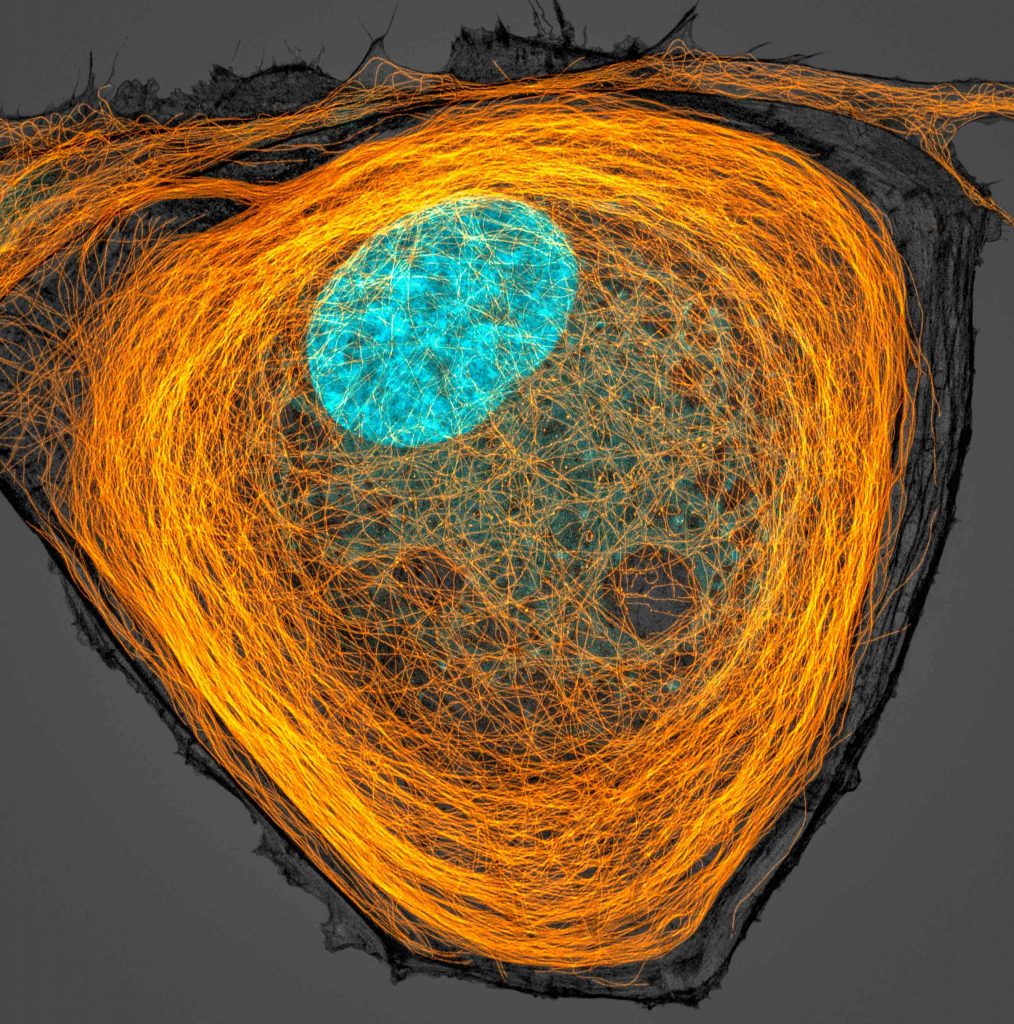
[In this figure] Fluorescence epitome of microtubule (orange), and the nucleus (cyan) within a cell.
Microtubule is one type of cytoskeleton inside the cells, and it shapes jail cell'south morphology. Magnification, 63x.
Photo credit: Jason Kirk, 2020 photomicrograph competition.
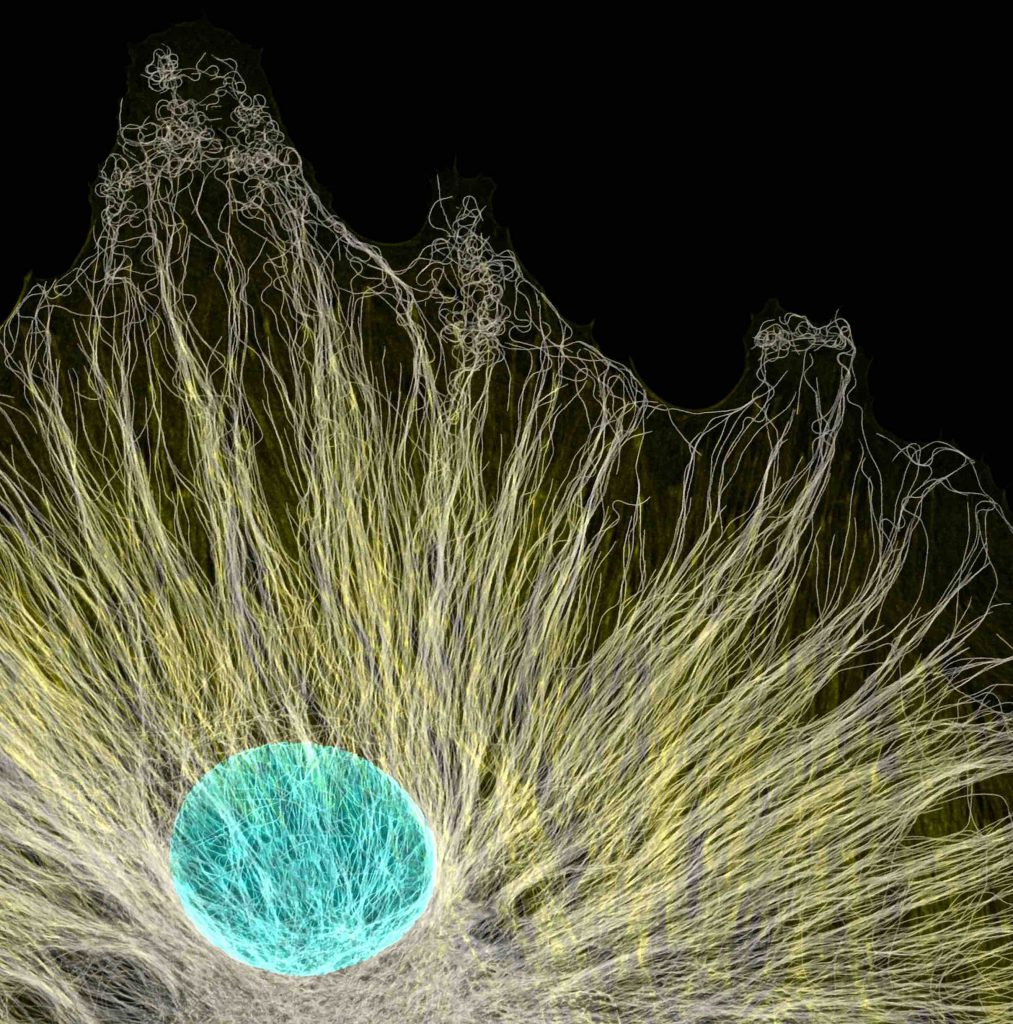
[In this figure] Fluorescence prototype of microtubule (yellowish) and the nucleus (cyan) inside a jail cell.
Microtubules radiated from a tissue prison cell culture. Discover that the microtubules extend to the very end of the jail cell membrane. Magnification, 63x.
Photo credit: Jason Kirk, 2020 photomicrograph competition.
Nucleus
- The nucleus (plural: nuclei) is a membrane-bound organelle that stores most of our genetic data (genome).
- The cardinal feature that separates eukaryotic cells (animals, plants, and fungi) from prokaryotic cells (bacteria and archaea) is the presence of a nucleus.
- The membrane of the nucleus is called the nuclear envelope. There are nuclear pores to control transportation beyond the envelope.
- During cell division, the nuclear envelope will temporally disappear to allow the separation of chromosomes.
- Both DNA replication and RNA transcription happen within the nucleus. Messager RNA (mRNA) that carries the genetic information will exist exported through nuclear pores into the cytosol for poly peptide synthesis (translation).
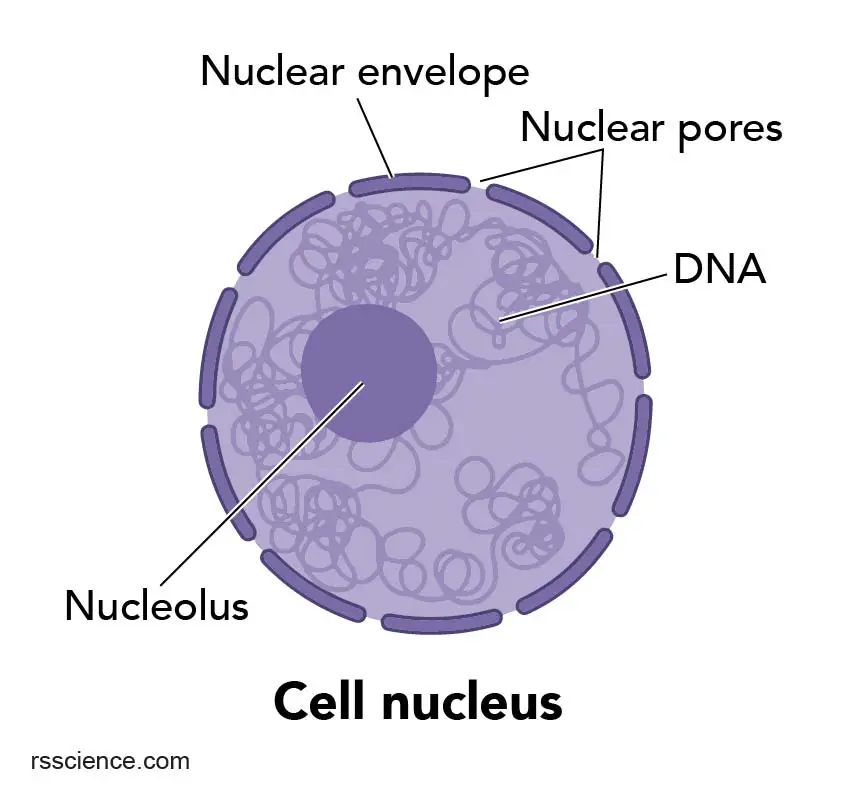
[In this figure] Cell nucleus is a membrane-bound organelle that stores Deoxyribonucleic acid.
The prototype was created with BioRender.com.
Nucleolus
- Nucleolus (plural: nucleoli) is a structure inside the nucleus.
- Nucleolus is known as the site of ribosome biogenesis.
Mitochondrion
- Mitochondrion (plural: mitochondria) is a rod-shaped organelle that is considered the ability generators of the cell.
- Mitochondrion performs cellular respiration, which converts glucose and oxygen to adenosine triphosphate (ATP). ATP is the biochemical free energy "currency" of the cell for all activities.
- Mitochondrion has double layers of the membrane: outer mitochondrial membrane (OMM) and inner mitochondrial membrane (IMM). Between the OMM and IMM is the intermembrane space. The region within the inner membrane is called the matrix.
- Mitochondrion generates ATP like a hydraulic dam. It happens via the electron transport chain beyond the IMM.
- Mitochondria (in institute cells, chloroplasts, too) are the just organelles that have their ain Deoxyribonucleic acid other than the nucleus. Mitochondrial Dna (mtDNA) is round and encoded only 13 genes.
- Scientists believe mitochondria and chloroplasts are derived from the bacteria that were engulfed by the early ancestors of today'due south eukaryotic cells. This theory is called the endosymbiotic theory.
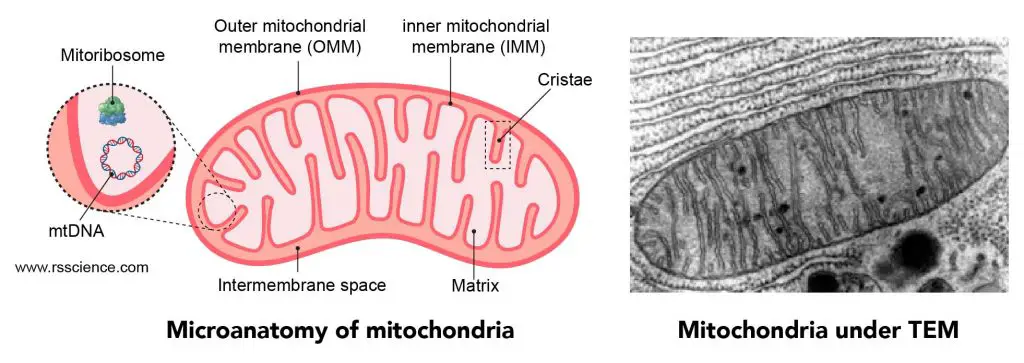
[In this effigy] Left: the construction of mitochondrion showing many folds of membranes and mtDNA. Right: a mitochondrion surrounded by crude ER nether a transmission electron microscope.
Endoplasmic reticulum
- Endoplasmic reticulum (ER) is an internal membrane that forms branching networks of many interconnected sacs and tubes.
- There are two types of ER: rough ER and smoothen ER.
- The outer side (facing the cytosol) of the rough ER is studded with ribosomes. Nether the electron microscope, the dense granular ribosomes gave the name of "rough" ER.
- Rough ER stays closer to the nucleus and coordinates poly peptide synthesis.
- Smooth ER lacks ribosomes. It specializes in lipid synthesis, steroid hormone production, and detoxification.
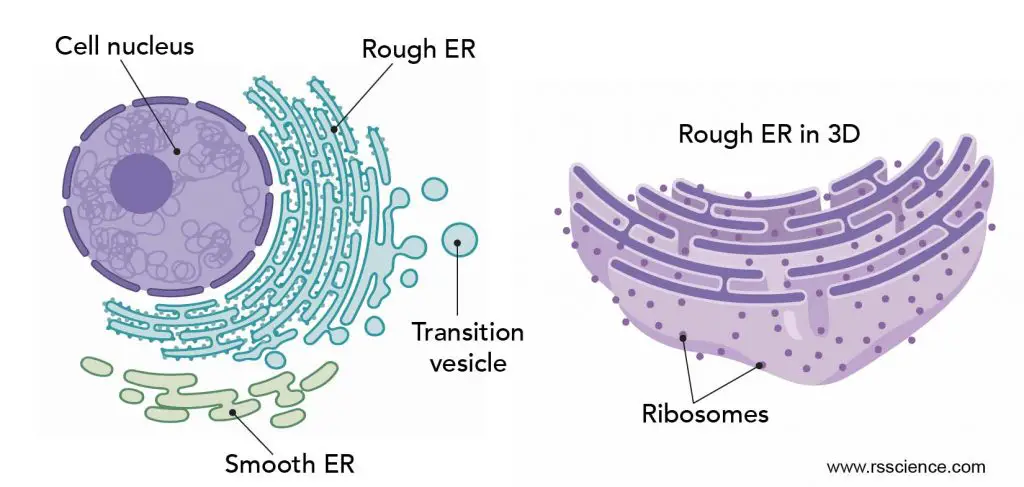
[In this figure] The anatomy of ER.
Left: The relationship betwixt the nucleus, rough, and polish ER. Right: A 3D view of rough ER.
The epitome was created with BioRender.com.
Ribosome
- Ribosomes are the places where proteins are synthesized in our cells.
- Ribosomes consist of 2 major components: the small and large ribosomal subunits. They are assembled by proteins and ribosomal RNA (rRNA).
- Ribosomes translate mRNA into polypeptide chains, which fold and gather into proteins.
- Transfer RNA (tRNA) carries the respective amino acid. Merely the correct tRNA can enter the ribosome and pair with the code on mRNA. Once the tRNA and mRNA match, the ribosome volition add this amino acrid onto a growing polypeptide concatenation.
- Ribosomes can exist found on the rough ER or free-floating in the cytosol.
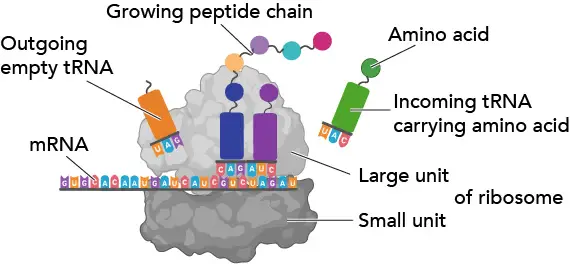
[In this effigy] The ribosome works similar a machine to interpret the code sequence of mRNA into a protein.
Golgi apparatus
- Golgi apparatus (or Golgi) consists of several stacks of membrane-bound cisternae (sacs).
- Golgi appliance ordinarily locates close to the ER. Information technology receives the raw protein products from the ER, modifies them (for example, calculation tags fabricated past sugar chains), and exports the proteins to a variety of destinations.
- The transportation of proteins is washed inside small bubbles, called vesicles.
- The vesicles are generated by budding from the membrane of the ER and Golgi. In one case the vesicles reach their destinations, the fusion of membrane releases their poly peptide cargos.
- At that place are 3 major destinations of proteins: (one) sent to other organelles, (2) released into the cytosol, and (3) secreted outside the cells. Secreting vesicles tin can also shop the proteins until they receive a signal to release at a specific event.
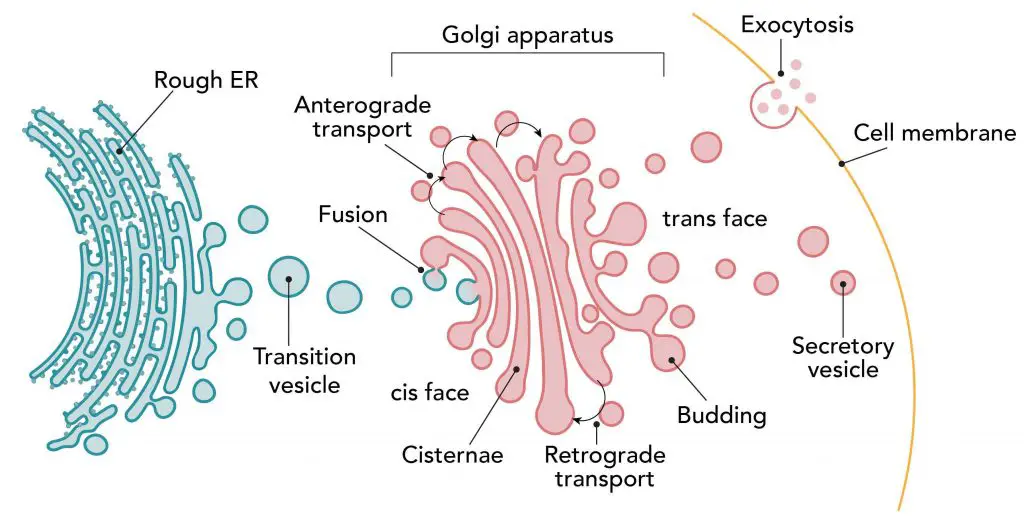
[In this effigy] The journey of protein synthesis and transportation.
After proteins are synthesized in the rough ER, they travel to the Golgi for farther modification. And so, proteins will be packed into vesicles and travel to their final destination.
Peroxisome
- Peroxisome is a spherical organelle responsible for the fatty acid (oil molecule) breakdown in society to generate free energy.
- Peroxisomes in the liver cells also handle the detoxification of many chemicals, including alcohol and drugs.
- Many enzymes within the peroxisomes catalyze Redox (reduction-oxidation) reactions, which will generate hydrogen peroxide (HiiOtwo) equally a dangerous byproduct.
- Peroxisomal enzyme, called "Catalase", tin convert H2O2 into water (H2O) and oxygen (O2) to keep the cell safe.
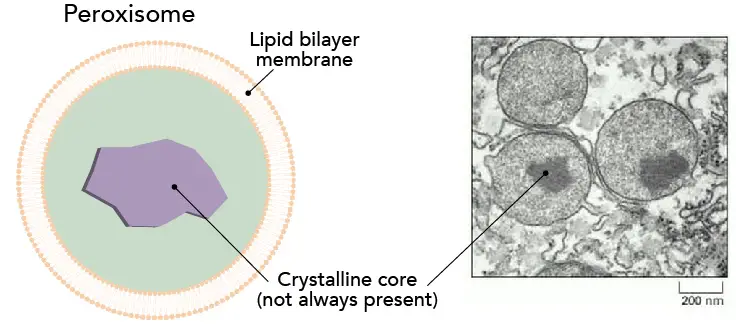
[In this figure] Peroxisomes.
Left: the structure of peroxisome. Right: an electron microscopy image of peroxisomes. (Prototype from Schrader, M. and Fahimi, H. 2008. The peroxisome: still a mysterious organelle.Histochemistry and Cell Biology 129(4), pp. 421-440.)
Lysosomes
- Lysosome is a membrane-bounded sphere full of digestive enzymes and works like a recycling centre in the cell.
- These enzymes can break down whatever substance entering the lysosomes into raw materials (like amino acids, nucleotides, lipids, and sugars), so the prison cell can reuse these raw materials to build new organelles.
- Inside the lysosome is an acidic environment (pH five), which activates the digestive enzymes. These enzymes won't be active in the cytosol (pH 7). This is a rubber mechanism in the prison cell in instance the lysosomes somehow leak or burst.
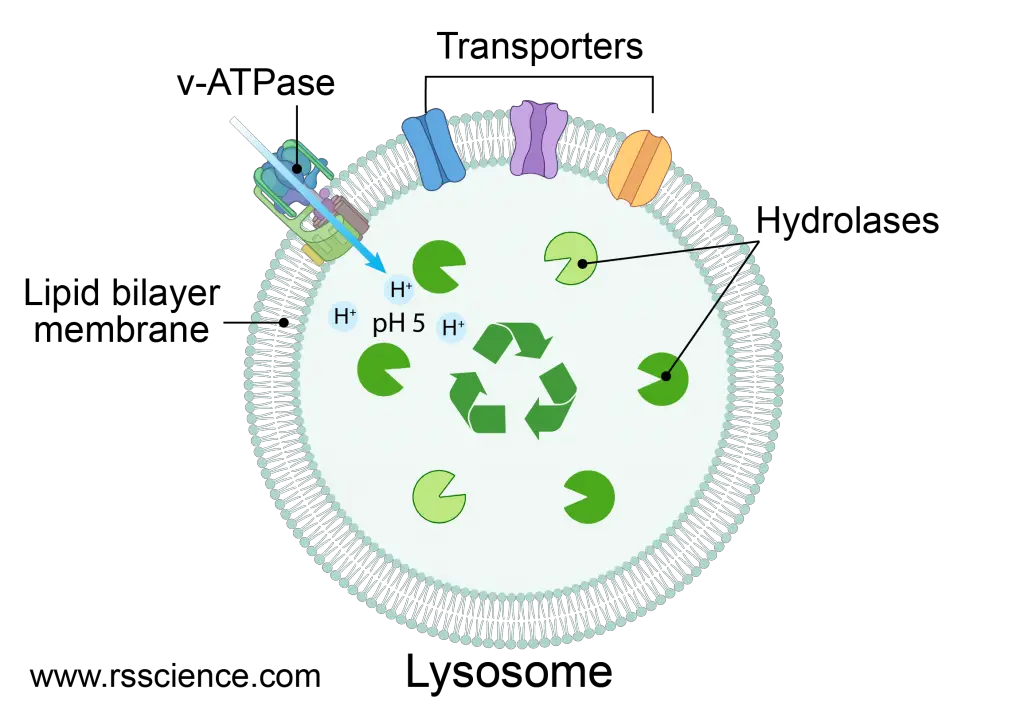
[In this figure] Lysosome is the recycling center of the cell.
ii. Temporary cell organelles for specific tasks
Autophagosome
- Autophagosome is a temporary organelle for autophagy.
- Autophagy (aka "self-eating") is a process that cells recycle some of their existed proteins and organelles due to the shortage of food supply.
- Damaged proteins or organelles will be put on a "garbage tags". The cell recognizes the tags and packs these recycle materials into autophagosomes.
- Autophagosomes acquit the cellular garbage to lysosomes for deposition.
- Special autophagy to dethrone bad mitochondria is named "mitophagy."
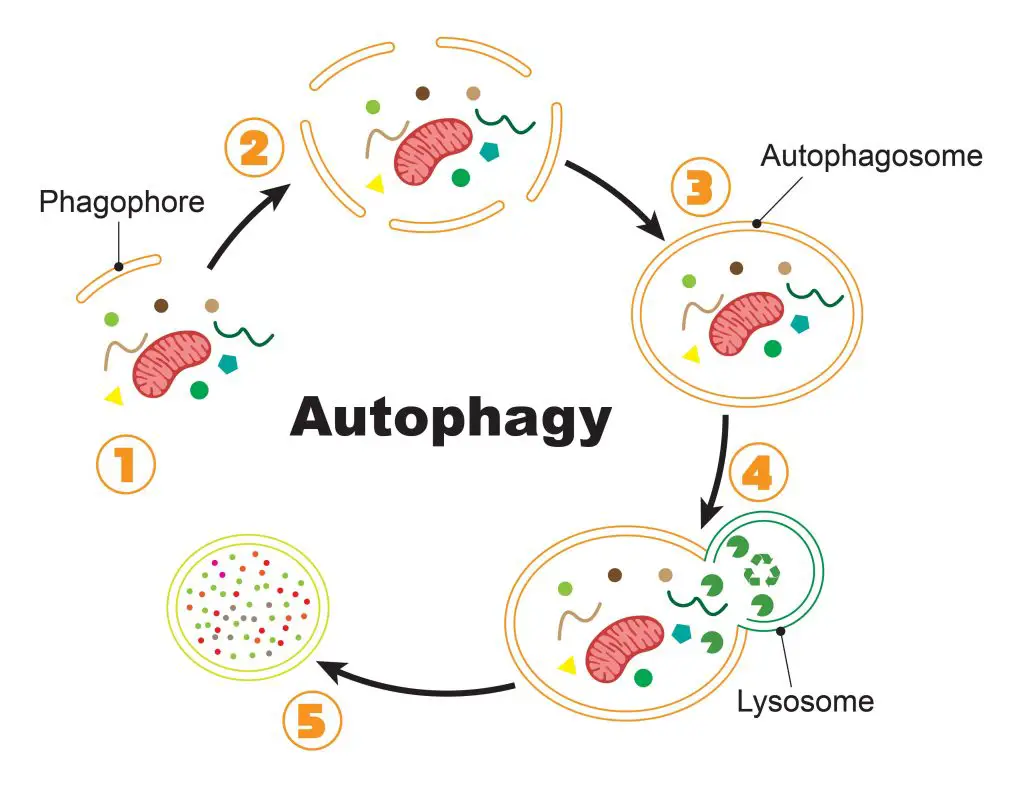
[In this figure] The process of autophagy.
Endosome
- Endosome is a membrane-bound temporary organelle for engulfing the stuff outside of the cell.
- Endosomes are formed past the invagination of the cell membrane, a process called "endocytosis."
- Later on endocytosis, the endosome can carry its cargo to different places in the cell.
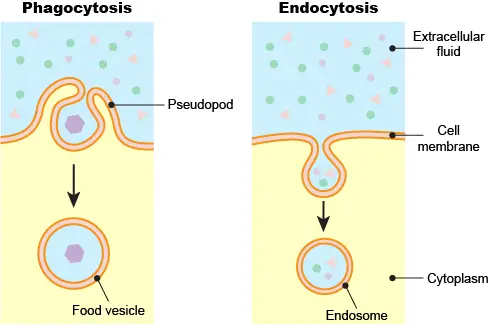
[In this effigy] Phagocytosis vs. Endocytosis.
Chromosome
- When the cells prepare for the cell division, each Deoxyribonucleic acid thread is organized into a much compact structure, called "chromosome".
- Every man prison cell has 23 pairs of chromosomes (one-22, and X or Y).
- A chromosome is formed by wrapping Dna effectually histone proteins into a core complex, called a nucleosome.
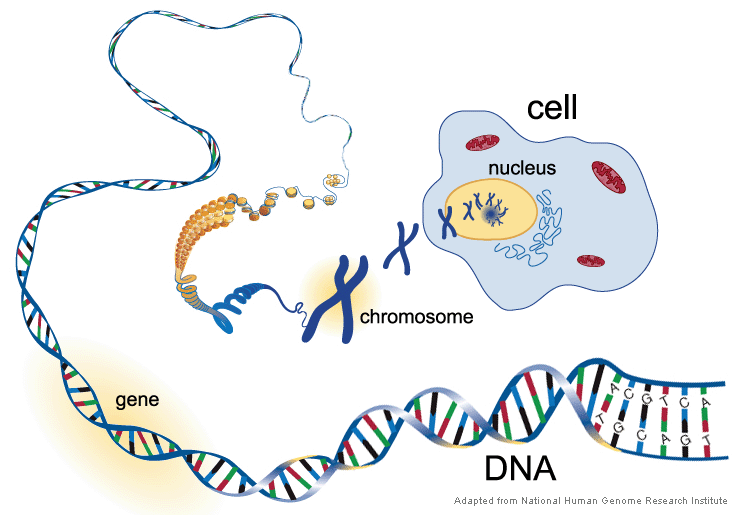
[In this figure] In order to handle the long Dna molecules, our cells pack Deoxyribonucleic acid threads into many meaty structures, called "chromosome".
Sister chromatids
- Sis chromatids are X-shaped chromosomes that remain attached at a centromeric region (centromere) after Dna duplication.
- Sister chromatids volition be separate into two identical chromosomes during mitosis.
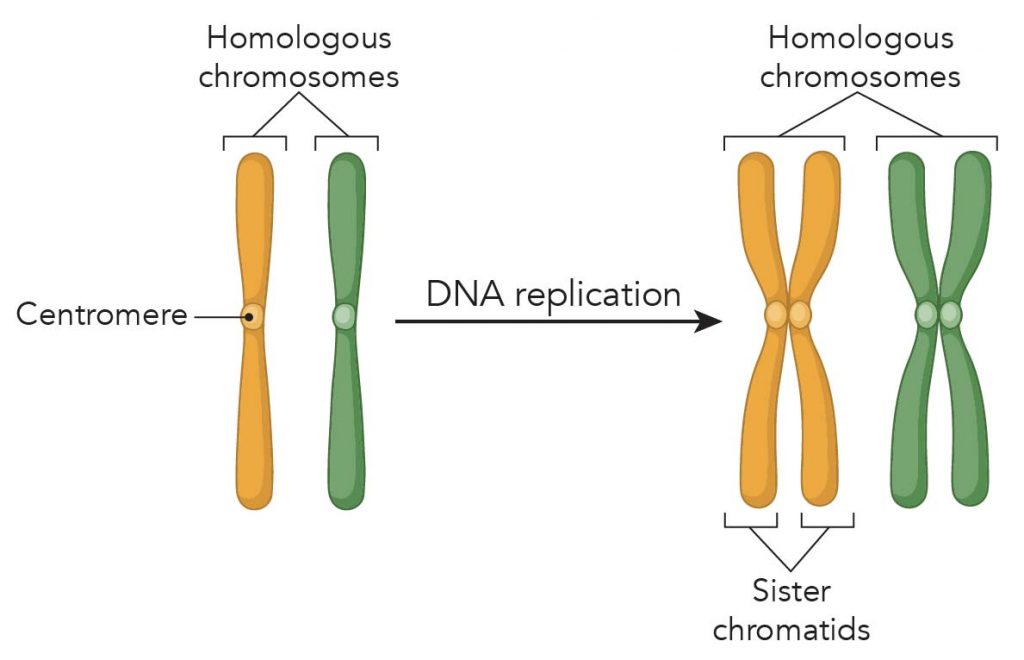
[In this effigy] Chromosome replication forms sister chromatids.
Centrosomes
- Centrosomes are organelles that only appear during mitosis and serve equally the main microtubule organizing eye (MTOC).
- Each cell has two centrosomes. They move toward the opposite positions of the cells when the mitosis starts.
- The microtubules extend from the centrosome and attach to the centromeres of sis chromatids. Both centromeres recollect their microtubule at the same time to split the sister chromatids autonomously and motility into new cells.
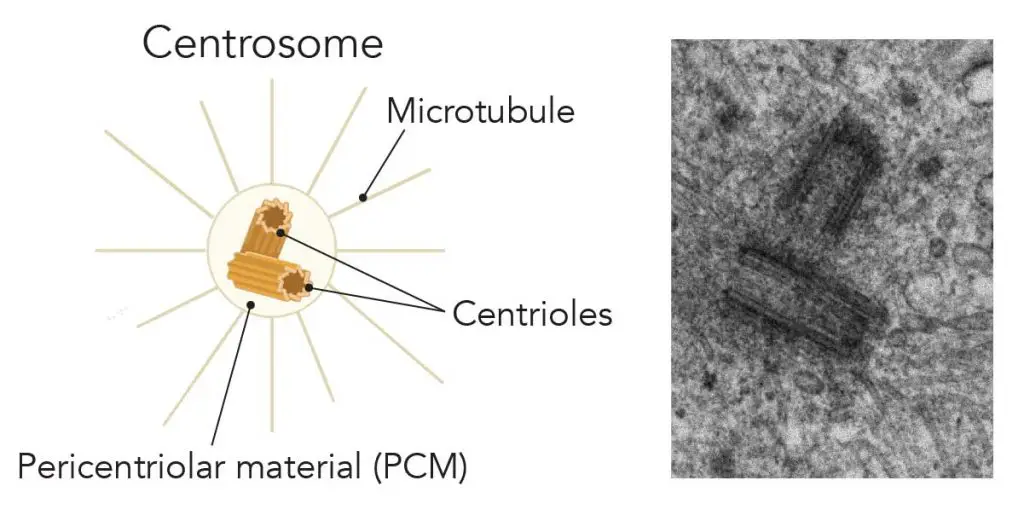
[In this figure] Analogy and electron micrography of the centrosome.
three. Unique cell organelles in the institute cells
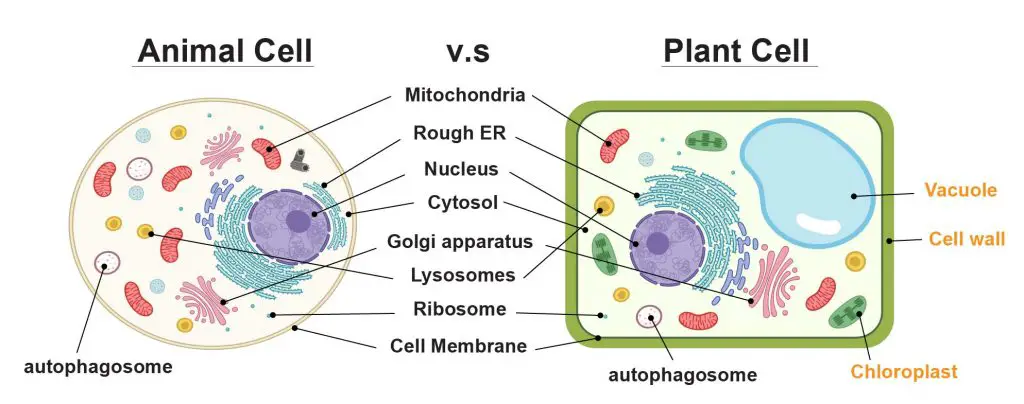
[In this effigy] The prison cell anatomy of beast and plant cells.
The animal cell and plant prison cell share many organelles in mutual, such as a nucleus, ER, cytosol, lysosomes, Golgi apparatus, cell membrane, and ribosomes. The organelles that are unique for found cells are Vacuole, Cell wall, and Chloroplast (shown in orangish text).
Cell wall
- Cell wall is an extra layer of structural support and protection outside the cell membrane of plant cells.
- Prison cell wall is fabricated of cellulose, a polymer type of sugars.
- The structural back up of cell walls allows plants to grow to smashing heights (similar pine trees). Wood is fabricated of the reminded cellulose fibers of jail cell walls afterward the death of matured xylem tissues of woody plants.
- When Robert C. Hooke came up with the term "Prison cell" in the 1660s, he was actually looking at the dead plant cells' cell walls in a thin cut of cork.
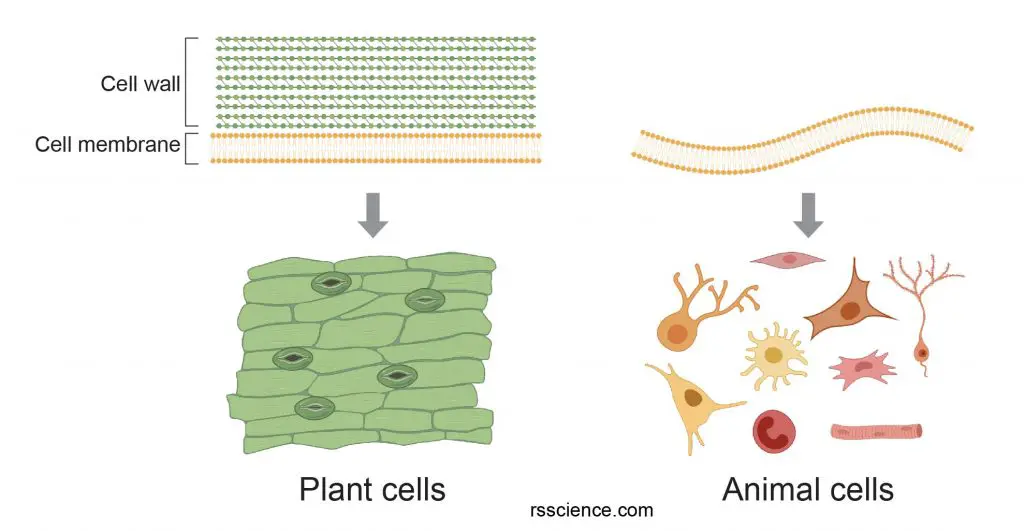
[In this figure] Prison cell wall provides additional protective layers outside the cell membrane.
Vacuole
- Vacuole is a membrane-bound organelle that contains a mass of fluid.
- Large, key vacuole is only present in the plant cells.
- Vacuole serves as a storage space for plant cells. Information technology can store a diversity of nutrients (including sugars, minerals, amino acids, nucleic acids, ions, and special chemicals) that a prison cell might need to survive.
- Vacuole also functions every bit a reservoir for the prison cell to store excess water. The amount of h2o in the vacuole volition determine the prison cell's turgor pressure (the hydrostatic pressure confronting the cell wall). A drooping plant has lost much of its water, and the vacuoles are shrinking.
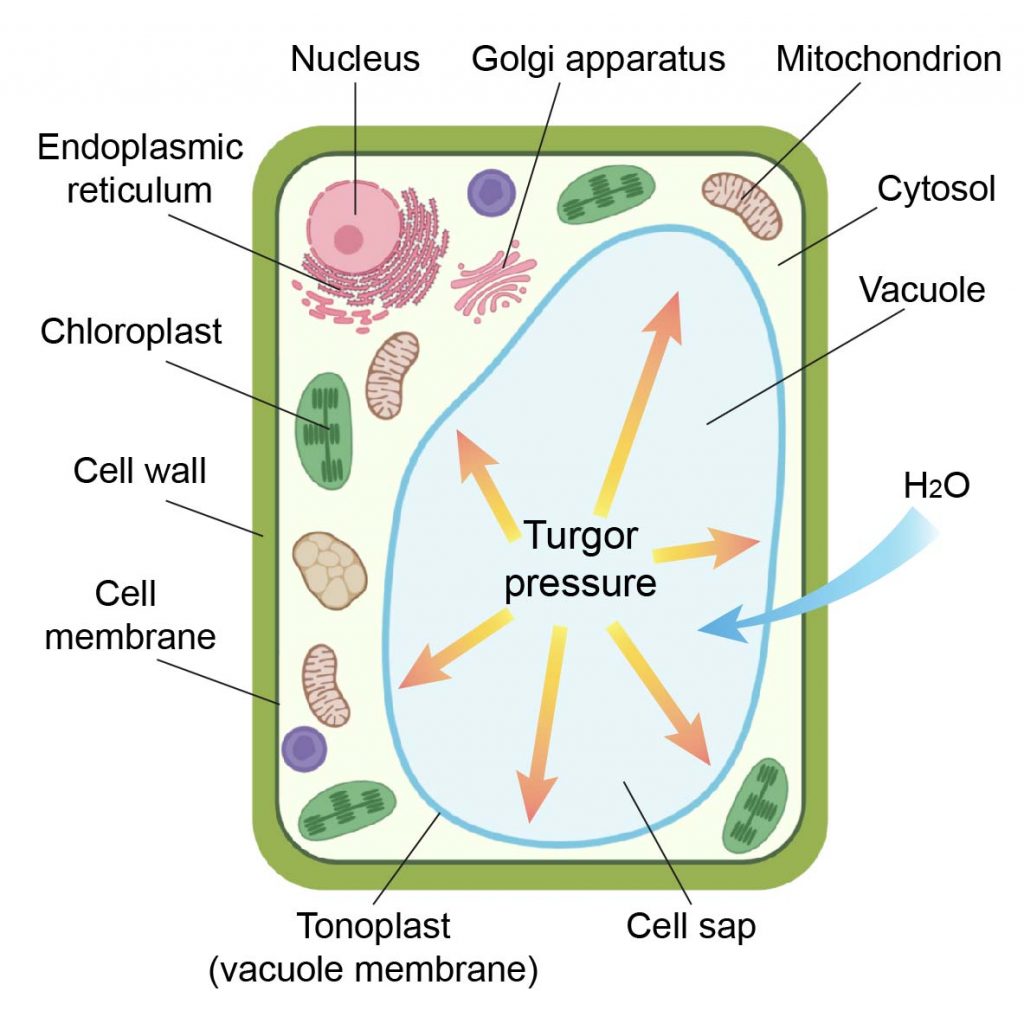
[In this figure] Drawing of a plant cell showing a large vacuole.
Chloroplast
- Chloroplasts are organelles that carry photosynthesis and produce energy for the plant cells.
- Chloroplasts convert the light energy of the Sun into sugars (a procedure chosen "photosynthesis") that tin exist used by cells. At the same time, the reaction produces oxygen (Otwo) and consumes carbon dioxide (CO2).
- Chloroplasts consist of many stacks of sac structures, called thylakoid organization. The molecules (Chlorophyll) that absorb the energy of the Sunday locate inside the thylakoid sacs.
- Chloroplast plays an important function in plant innate immunity.
- Chloroplasts and mitochondria share many in common. They both have two layers of membranes, their own Deoxyribonucleic acid and ribosomes. They are believed to be derived from endosymbiotic bacteria engulfed by the early on ancestors of today's eukaryotic cells.
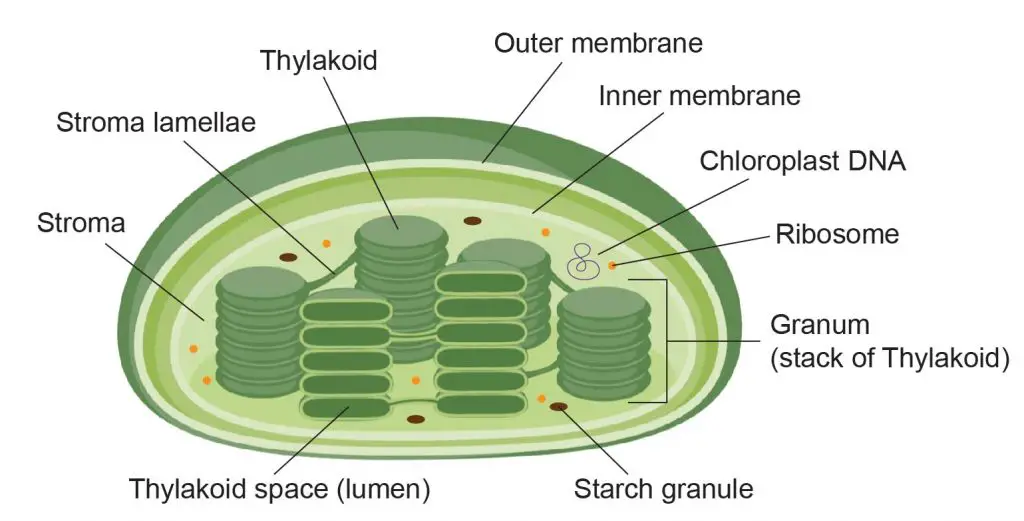
[In this figure] The structure of chloroplast.
Related posts
Animal Cell Model Function I – cell membrane, cytosol, nucleus, and mitochondria.
Creature Jail cell Model Part II – endoplasmic reticulum, ribosome, Golgi apparatus, peroxisome, and lysosomes.
Beast Cell Model Role III – two types of temporary organelles involving eating behaviors, autophagosomes, and endosomes.
Animal Cell Model Part IV – ii types of temporary organelles only appearing during mitosis, centrosomes, and chromosomes.
Plant Jail cell Model Office 5 – cell wall, vacuole, and chloroplast.
Source: https://rsscience.com/cell-organelles-and-their-functions/
Posted by: robinsongropen.blogspot.com

0 Response to "Which Organelles Are Unique To Animal Cells Quizlet"
Post a Comment